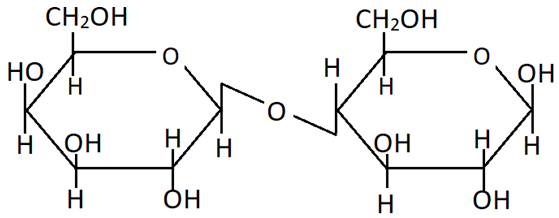This set of Class 12 Chemistry Chapter 14 Multiple Choice Questions & Answers (MCQs) focuses on “Biomolecules Carbohydrates – 4”.
1. Disaccharides on _______ with dilute HCl yield two same or different monosaccharides.
a) hydration
b) hydrolysis
c) oxidation
d) carbonation
View Answer
Explanation: Disaccharides react with water in the presence of dilute acids or enzymes to give two monosaccharide units. These units may be same of different.
2. Which of the following disaccharides on hydrolysis with invertase gives two different monosaccharides?
a) Sucrose
b) Lactulose
c) Lactose
d) Maltose
View Answer
Explanation: Invertase is an enzyme that specifically acts on sucrose. It is named so because it forms invert sugar which is a mixture of glucose and fructose.
3. Two monosaccharides are joined through a ______ bond to form a disaccharide.
a) ionic
b) peptide
c) glycosidic
d) phosphodiester
View Answer
Explanation: Two monosaccharide units together lose a molecule of water and combine by an oxide linkage. Such a bond between two monosaccharide units through oxygen atom is called glycosidic linkage.
4. Sucrose is a _______ compound and the product mixture obtained from its hydrolysis is _______ in nature.
a) dextrorotatory; dextrorotatory
b) dextrorotatory; laevorotatory
c) laevorotatory; dextrorotatory
d) laevorotatory; laevorotatory
View Answer
Explanation: Sucrose is dextrorotatory but on hydrolysis gives a mixture dextrorotatory glucose and laevorotatory fructose. Since, the specific rotation of fructose is greater than that of glucose, the resultant mixture is laevorotatory.
5. Which of the following is false regarding the reaction of sucrose to give fructose and glucose?
a) It can take place in the presence of enzyme sucrase
b) It results in the formation of a glycosidic bond.
c) It is an inversion reaction
d) It is a hydrolysis reaction
View Answer
Explanation: Hydrolysis of sucrose (in the presence of either dilute acid, invertase or sucrase) results in the cleavage of glycosidic bond to give glucose and fructose. Sucrase results in the cleavage of O-C(glucose) bond, whereas invertase results in the cleavage of O-C(fructose bond).
6. Sucrose is made of which of the following monosaccharides?
a) α-D-glucose, α-D-fructose
b) α-D-glucose, β-D-fructose
c) β-D-glucose, α-D-fructose
d) β-D-glucose, β-D-fructose
View Answer
Explanation: Sucrose is composed of α-D-glucose and β-D-fructose. These two are held together by an α,β-glycosidic linkage between C1 of glucose (pyranose) and C2 of fructose (furanose).
7. Identify the enzyme X in the following reaction.

a) Amylase
b) Maltase
c) Zymase
d) Diastase
View Answer
Explanation: Diastase is an enzyme present in malt sugar that particularly catalyses the hydrolysis of starch to maltose. Amylase, maltase and zymase help in the breakdown of certain saccharides into other compounds.
8. Which of the following is incorrect regarding maltose?
a) It consists of two glucopyranose units
b) It is a non-reducing sugar
c) Glycosidic bond between C1 of one unit and C4 of the other unit
d) It is a disaccharide
View Answer
Explanation: The free aldehyde group can be produced at the C1 carbon of the second α-D-glucose unit in solution and it shows reducing properties. Hence, it is a reducing sugar.
9. Which of the following is also known as beet sugar?
a) Fructose
b) Sucrose
c) Maltose
d) Lactose
View Answer
Explanation: Sucrose is widely distributed among plants, particularly sugarcane and sugar beet. The sugar obtained from sugar beet is known as beet sugar, whereas that obtained from sugarcane is cane sugar.
10. Identify the saccharide from the Haworth projection shown below.

a) Lactose
b) Maltose
c) Sucrose
d) Trehalose
View Answer
Explanation: It is composed of β-D-galactose (left) and β-D-glucose (right). There is a β-glycosidic linkage between the C1 of galactose and C4 of glucose unit. It is a non-reducing sugar.
11. Which of the following statements is incorrect with respect to starch?
a) It is a reducing carbohydrate
b) It is a polymer of α-D-glucose
c) It gives blue colour with iodine
d) It consists of branched chains
View Answer
Explanation: Starch is a non-reducing saccharide as it does not reduce Fehling’s solution or Tollen’s reagent. This indicates that all hemiacetal hydroxyl groups of glucose units are not free nut are linked by glycosidic bonds.
12. Amylum is one of the components of starch.
a) True
b) False
View Answer
Explanation: Starch is a polymer of α-glucose consisting of two components namely, amylose and amylopectin. Amylum is just another common name for starch.
13. The branching in the ________ component of starch occurs by the glycosidic linkage between _______ carbons.
a) amylose; C1-C4
b) amylose; C1-C6
c) amylopectin; C1-C4
d) amylopectin; C1-C6
View Answer
Explanation: Amylopectin is the water insoluble branched constituent of starch which makes up 80-85% of its structure. It consists of straight chains of glucose through C1-C4 linkage, with the C1 of the terminal glucose of each chain linking with the C6 of another glucose unit in the next chain.
14. Cellulose is a _______ saccharide.
a) reducing
b) branched chain
c) β-glucose straight chain
d) oligo
View Answer
Explanation: Cellulose is a straight chain polysaccharide composed of only β-D-glucose units which are joined by glycosidic links between C1 of one glucose unit and C4 of the next glucose unit.
15. Starch : Plants : : X : Animals. Identify X.
a) Starch
b) Glucose
c) Cellulose
d) Glycogen
View Answer
Explanation: Starch is the main storage polysaccharide of plants. On the other hand, carbohydrates are stored in animals in the form of glycogen. It is also known as animal starch because of its similar structure to amylopectin.
Sanfoundry Global Education & Learning Series – Chemistry – Class 12.
To practice all chapters and topics of class 12 Chemistry, here is complete set of 1000+ Multiple Choice Questions and Answers.
If you find a mistake in question / option / answer, kindly take a screenshot and email to [email protected]
- Check Class 12 - Chemistry Books
- Practice Class 12 - Mathematics MCQs
- Practice Class 12 - Biology MCQs
- Practice Class 11 - Chemistry MCQs
- Practice Class 12 - Physics MCQs
